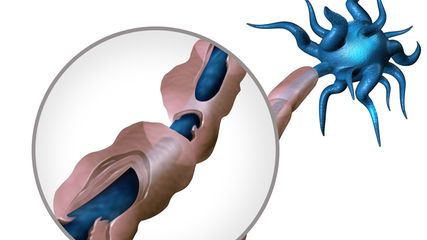<p class="article-intro">Recent evidence indicates that Alzheimer’s disease (AD) risk, symptoms and progression might vary according to biological sex. Considering sex diff erences in prevention, diagnosis and treatment strategies might improve patient management and clinical trials.</p>
<hr />
<p class="article-content"><p>AD, the leading cause of dementia in the elderly, varies greatly across patients in terms of onset, risk factors, symptoms, progression, biomarker profile and response to treatment.<br /> High phenotypic variability has so far delayed precise diagnosis, and hindered the detection of a significant signal in clinical trial outcomes.<sup>1</sup> Understanding genetic and phenotypic factors driving AD variability promises to improve diagnostic accuracy and drug efficacy. While sex differences have been increasingly reported in the cardiovascular field, and implemented into official guidelines of the American Heart Association,<sup>2</sup> the study of sex differences in AD is in its infancy. For a long time, the vast majority of clinical and epidemiological studies has only “adjusted“ data by sex; biological sex is often included as a covariate in multivariate analyses. Only in recent years studies have started to specifically stratify data by sex, and investigate statistical interactions, revealing an unexpected role of biological sex in AD variability (recently reviewed here<sup>3</sup>).</p> <h2>Sex differences in disease symptoms and progression</h2> <p><strong>Cognitive symptoms</strong><br /> Amongst non-cognitively impaired individuals, subtle sex differences in neuropsychological performance have been reported. In most studies, women tend to outperform men in tests of verbal memory, while men present higher scores than women in visuospatial abilities. The female advantage in verbal memory is retained also at the mild cognitive impairment (MCI) stage, prodromal to AD4; however, it is lost at AD diagnosis.<sup>3</sup> According to a recent metaanalysis of 15 clinical studies (n = 828 men; 1,238 women), male AD patients modestly but significantly outperformed women in all of the cognitive domains examined, even after adjusting for confounding factors.<sup>5</sup> Hence, after diagnosis, women lose their advantage and present with equal or stronger cognitive deficits than men. These results are interpreted as a sign of delayed diagnosis or faster cognitive decline in women than men.<br /><br /> <strong>Progression and other symptoms</strong><br /> Indeed, several reports from the Alzheimer’s Disease Neuroimaging Initiative (ADNI) cohort have shown that women with MCI have greater rates of cognitive decline than men.<sup>6</sup> In addition to sex differences in cognition, neuropsychiatric symptoms also vary by sex, with women presenting more often with depression and psychotic traits.<sup>7</sup><br /><br /> <strong>Implications</strong><br /> The occurrence of sex differences in symptoms and progressions has important implications for clinical diagnosis of AD. For example, at early stages of the disease continuum, standard neuropsychological tests relying on verbal memory might fail to identify subtle deficits in women, who retain an advantage in this domain up to the MCI stage.<sup>4</sup> In clinical trials, biological sex might need to be considered for patients’ stratification into slow and fast progressors.</p> <h2>Sex differences in imaging and fluid biomarkers</h2> <p>Suspected AD dementia clinical diagnosis is supported by biomarker evidence of brain atrophy (measured via MRI), altered brain metabolism (measured via 2-[fluorine-18]fluoro-2-deoxy-D-glucose, FDG-PET) and of pathological hallmarks of the disease (mostly amyloid beta peptide and abnormally phosphorylated tau).<sup>8</sup><br /><br /> <strong>Imaging biomarkers of neurodegeneration</strong><br /> Several recent studies have documented sex differences in brain atrophic patterns and rates in both cognitively healthy subjects and in the AD spectrum. In most studies, cognitively healthy men appear to show higher neurodegenerative markers than women, with lower measures of cortical thickness, FDG-PET uptake and resting state MRI<sup>9,10</sup> (see also Tab. 1). Since these changes occur in cognitively healthy individuals, the results are interpreted as an indication of higher male resilience to AD neuropathology. However, even though men have greater brain atrophy at baseline, MCI women were shown to have faster atrophic rates than men.<sup>11</sup><br /><br /> <strong>Amyloid-beta and tau</strong><br /> Until today, sex-stratified analyses have not identified sex differences in CSF amyloid-beta and tau levels, nor in global measures of amyloid beta in brain via PET tracers.<sup>3</sup> A more in-depth analysis might yield different results. For instance, regional analysis of PET amyloidbeta signal has revealed higher amyloid accumulation in anterior cingulate cortex in cognitively healthy men than women (Tab. 1).<sup>10</sup> In addition, a new, fully automated and standardized immunoassay for amyloid beta peptide and tau measurement in CSF has recently received breakthrough device designation from FDA.<sup>12</sup> While this assay was shown to identify, based on a predefined cut-off value, MCI patients who will progress towards AD-dementia, it is currently not known whether the cut-off performs equally well for men and women patients. Further analyses to elucidate sex differences using this and other biomarker diagnostic approaches are needed.<br /><br /> <strong>Implications</strong><br /> Importantly, even when baseline data do not differ by sex, there is evidence that the downstream effect of cerebral accumulation of amyloid beta and phosphorylated tau might differ between men and women. Presence of these pathological hallmarks of AD pathology resulted in faster hippocampal atrophy and cognitive decline in women than men;<sup>13</sup> similarly, recent evidence revealed that elevated amyloid-beta levels correlate with faster cognitive decline in elderly women than elderly men.<sup>14</sup> Sex-adjusted cut-offs for imaging and fluid biomarkers might be needed, in order to improve their diagnostic precision.</p> <p><img src="/custom/img/files/files_datafiles_data_Zeitungen_2018_Jatros_Neuro_1805_Weblinks_s10_tab1.jpg" alt="" width="2151" height="1213" /></p> <h2>Sex differences in risk factors</h2> <p><strong>Sex as a risk modifier</strong><br /> A growing body of evidence indicates that sex might modulate the effect of wellknown lifestyle and genetic risk factors. In particular, current smoking, dyslipidemia, midlife hypertension and diabetes were shown to predict MCI in cognitively healthy women – but not in men, at 5 years follow-up in the Mayo Clinic Study of Aging; in this study, significant predictors for men were obesity and “never married?/“widowed? status.<sup>15</sup><br /><br /> The most important genetic risk factor for AD is the APOE*ε4 allele; AD risk conferred by APOE allelic status is subtly modulated by sex. A global meta-analysis including more than 50,000 individuals has revealed an increased incidence of MCI or AD in female APOE*ε4 carriers, as compared to male carriers, only in younger age brackets (55–70 years for MCI and 65–75 years for AD), while the risks are not significantly different between older men carriers and older women carriers.<sup>16</sup> The reasons for such early susceptibility of women carriers are unknown. <br /><br /><strong>Female-specific risk factors</strong><br /> Importantly, there are several femalespecific risk factors that have been only superficially studied, including number of pregnancies and pregnancy-related hypertensive disorders such as pre-eclampsya. Early menopause (menopause before the age of 40–45 which results from ovarian removal, chemotherapy, aromatase inhibitor treatment or premature ovarian insufficiency) has been consistently linked to increased risk of cognitive decline and dementia.<sup>17</sup><br /><br /> <strong>Implications</strong><br /> A better knowledge and communication of sex-related and sex-specific risk factors amongst clinicians and patients could help identifying men and women at higher risk and inform clinical decisions, such as lifestyle modification and personalized preventive medical treatment.</p> <h2>Conclusions</h2> <p>Biological sex could be one of the drivers of phenotypic variability seen at group level in AD patients.<sup>3</sup> A thorough characterization of such sex differences has the potential to improve individuallevel prediction of disease based on biomarkers, to promote early diagnosis and to optimize clinical trial design and outcomes in AD. Biological sex in AD should be studied in the larger context of precision medicine, a novel, integrated approach that aims at providing tailored interventions to each patient. The Alzheimer’s Disease Precision Medicine Initiative (APMI) was recently launched to promote precision medicine in AD.<sup>18</sup></p></p>
<p class="article-footer">
<a class="literatur" data-toggle="collapse" href="#collapseLiteratur" aria-expanded="false" aria-controls="collapseLiteratur" >Literatur</a>
<div class="collapse" id="collapseLiteratur">
<p><strong>1</strong> Au R et al.: Back to the future: Alzheimer's disease heterogeneity revisited. Alzheimers Dement (Amst) 2015; 1: 368-70 <strong>2</strong> Bushnell C et al.: Guidelines for the prevention of stroke in women: a statement for healthcare professionals from the American Heart Association/American Stroke Association. Stroke 2014; 45: 1545-88 <strong>3</strong> Ferretti MT et al.: Sex differences in Alzheimer disease - the gateway to precision medicine. Nat Rev Neurol 2018; 14: 457- 69 <strong>4</strong> Sundermann EE et al.: Better verbal memory in women than men in MCI despite similar levels of hippocampal atrophy. Neurology 2016; 86: 1368-76 <strong>5</strong> Irvine K et al.: Greater cognitive deterioration in women than men with Alzheimer's disease: a meta analysis. J Clin Exp Neuropsychol 2012; 34: 989-98 <strong>6</strong> Lin KA et al.: Marked gender differences in progression of mild cognitive impairment over 8 years. Alzheimers Dement 2015; 1: 103-10 <strong>7</strong> Hollingworth P et al.: Four components describe behavioral symptoms in 1,120 individuals with late-onset Alzheimer's disease. J Am Geriatr Soc 2006; 54: 1348-54 <strong>8</strong> Dubois B et al.: Advancing research diagnostic criteria for Alzheimer's disease: the IWG-2 criteria. Lancet Neurol 2014; 13: 614-29 <strong>9</strong> Jack Jr. CR et al.: Age-specific and sex-specific prevalence of cerebral beta-amyloidosis, tauopathy, and neurodegeneration in cognitively unimpaired individuals aged 50-95 years: a cross-sectional study. Lancet Neurol 2017; 16: 435-44 <strong>10</strong> Cavedo E et al.: Sex differences in functional and molecular neuroimaging biomarkers of Alzheimer's disease in cognitively normal older adults with subjective memory complaints. Alzheimers Dement 2018; 14: 1204-15 <strong>11</strong> Hua X et al.: Sex and age differences in atrophic rates: an ADNI study with n=1368 MRI scans. Neurobiol Aging 2010; 31: 1463-80 <strong>12</strong> Hansson O et al.: CSF biomarkers of Alzheimer's disease concord with amyloid- beta PET and predict clinical progression: A study of fully automated immunoassays in BioFINDER and ADNI cohorts. Alzheimers Dement 2018; https://doi.org/10.1016/j. jalz.2018.01.010 <strong>13</strong> Koran ME et al.: Sex differences in the association between AD biomarkers and cognitive decline. Brain Imaging Behav 2017; 11: 205–13 <strong>14</strong> Buckley RF et al.: Sex, amyloid, and APOE epsilon4 and risk of cognitive decline in preclinical Alzheimer's disease: Findings from three well-characterized cohorts. Alzheimers Dement 2018; 14: 1193-203 <strong>15</strong> Pankratz VS et al.: Predicting the risk of mild cognitive impairment in the Mayo Clinic Study of Aging. Neurology 2015; 84: 1433-42 <strong>16</strong> Neu SC et al.: Apolipoprotein E genotype and sex risk factors for Alzheimer disease: a meta-analysis. JAMA Neurol 2017; 74: 1178-89 <strong>17</strong> Rocca WA.: Increased risk of cognitive impairment or dementia in women who underwent oophorectomy before menopause. Neurology 2007; 69: 1074-83 <strong>18</strong> Hampel H et al.: Revolution of Alzheimer precision neurology passageway of systems biology and neurophysiology. J Alzheimers Dis 2018; pub ahead of print</p>
</div>
</p>



